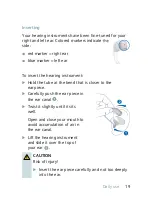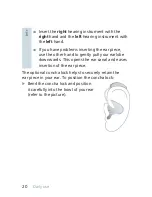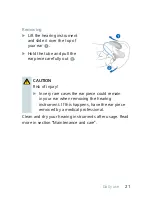
Daily use
25
Using two hearing instruments (optional)
Very rarely does hearing loss occur in only one ear,
therefore the use of two instruments ensures that you are
improving your hearing in all situations allowing you to
better participate in your daily life.
When controlling two instruments you have the following
options to, for example, change the hearing program:
■
You can control each hearing instrument separately.
■
You can control both hearing instruments
simultaneously.
Your Hearing Care Professional has to activate the
"e2e wireless" function, enabling both hearing
instruments to exchange information. You can then
use either a remote control or the user controls on
either of your instruments for the desired function e.g.
volume change.
The control elements of both instruments can even be set
differently – thus offering you the degree of control you
really need.
Summary of Contents for Orion P
Page 45: ...Country specific informatio 45 Country specific information ...
Page 46: ...46 ...
Page 47: ......
















































